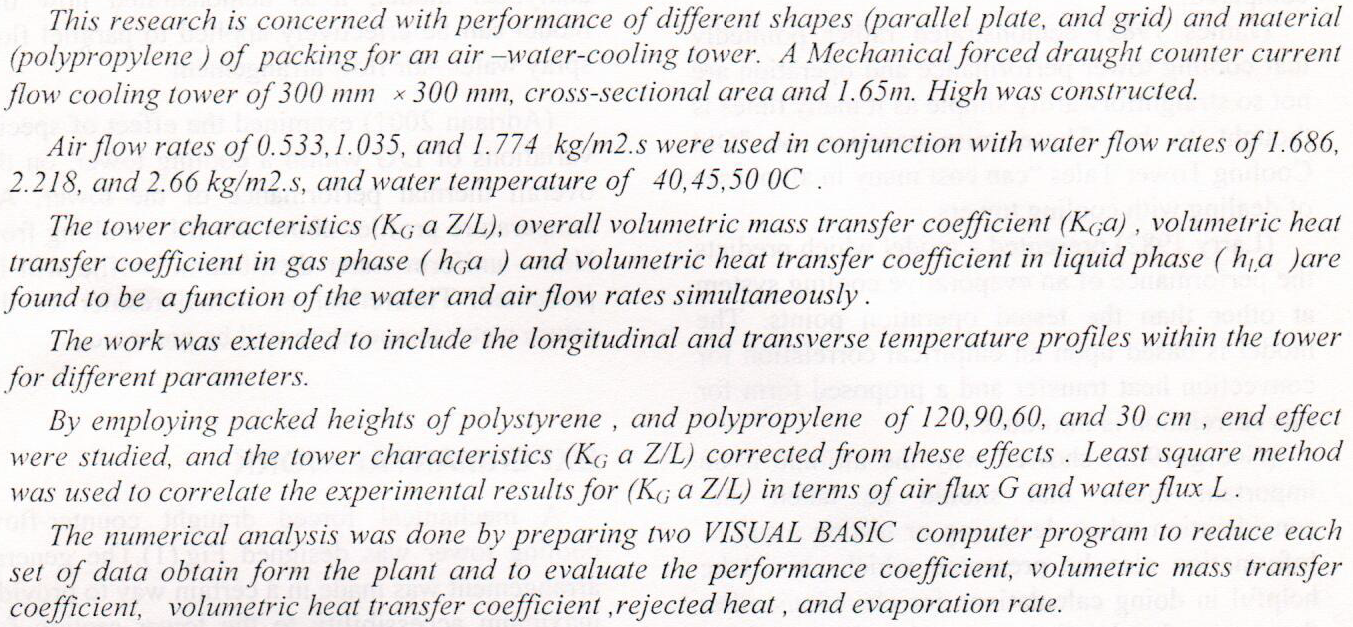
In this work, an inventive photovoltaic evaporative cooling (PV/EC) hybrid system was constructed and experimentally investigated. The PV/EC hybrid system has the prosperous advantage of producing electrical energy and cooling the PV panel besides providing cooled-humid air. Two cooling techniques were utilized: backside evaporative cooling (case #1) and combined backside evaporative cooling with a front-side water spray technique (case #2). The water spraying on the front side of the PV panel is intermittent to minimize water and power consumption depending on the PV panel temperature. In addition, two pad thicknesses of 5 cm and 10 cm were investigated at three different water flow rates of 1, 2, and 3 lpm. In Case #1,
... Show More (5)
(5)
The performance of a solar assisted desiccant cooling system for a meeting-hall located in the College of Engineering/University of Baghdad was evaluated theoretically. The system was composed of four components; a solar air heater, a desiccant dehumidifier, a heat exchanger and an evaporative cooler. A computer simulation was developed by using MATLAB to assess the effect of various design and operating conditions on the performance of the system and its components. The actual weather data on recommended days were used to assess the load variation and the system performance during those days. The radiant time series method (RTS) was used to evaluate the hourly variation of the cooling load. Four operation modes were employed for perform
... Show MoreThe experimental study showed the use of closed cavity wall (the thickness of the cavity 5cm) made a percentage reduction in the cooling load caused by heat gain from the wall by (21.5 %) compared with the conventional wall. also the thermal resistance of the closed cavity was an average (0.2 m2.oC/W).
The experimental results of the study showed that the use of closed cavity wall reduced the average temperature of the inner surface of the wall during the day, and that the reduction was an average (0.45 oC) when compared with the conventional wall , as well as the use of closed cavity wall reduced the temperature difference range of the inner surface of the wall during the day, and that the
... Show MoreIn this research the effect of cooling rate and mold type on mechanical properties of the eutectic
and hypoeutectic (Al-Si) alloys has been studied. The alloys used in this research work were (Al- 12.6%Si
alloy) and (Al- 7%Si alloy).The two alloys have been melted and poured in two types of molds with
different cooling rates. One of them was a sand mold and the other was metal mold. Mechanical tests
(hardness, tensile test and impact test) were carried out on the specimens. Also the metallographic
examination was performed.
It has been found that the values of hardness for the alloys(Al-12.6%Si and Al-7%Si) which poured in
metal mold is greater than the values of hardness for the same alloy when it poured in a heated
 (2)
(2)
The present study involves experimental analysis of the modified Closed Wet Cooling Tower (CWCT) based on first and second law of thermodynamics, to gain a deeper knowledge in this important field of engineering in Iraq. For this purpose, a prototype of CWCT optimized by added packing under a heat exchanger was designed, manufactured and tested for cooling capacity of 9 kW. Experiments are conducted to explore the effects of various operational and conformational parameters on the towers thermal performance. In the test section, spray water temperature and both dry bulb temperature and relative humidity of air measured at intermediate points of the heat exchanger and packing. Exergy of water and air were calculated by applying the exergy
... Show MoreThe Jeribe reservoir in the Jambour Oil Field is a complex and heterogeneous carbonate reservoir characterized by a wide range of permeability variations. Due to limited availability of core plugs in most wells, it becomes crucial to establish correlations between cored wells and apply them to uncored wells for predicting permeability. In recent years, the Flow Zone Indicator (FZI) approach has gained significant applicability for predicting hydraulic flow units (HFUs) and identifying rock types within the reservoir units.
This paper aims to develop a permeability model based on the principles of the Flow Zone Indicator. Analysis of core permeability versus core porosity plot and Reservoir Quality Index (RQI) - Normalized por
... Show More (2)
(2)
The Jeribe reservoir in the Jambour Oil Field is a complex and heterogeneous carbonate reservoir characterized by a wide range of permeability variations. Due to limited availability of core plugs in most wells, it becomes crucial to establish correlations between cored wells and apply them to uncored wells for predicting permeability. In recent years, the Flow Zone Indicator (FZI) approach has gained significant applicability for predicting hydraulic flow units (HFUs) and identifying rock types within the reservoir units. This paper aims to develop a permeability model based on the principles of the Flow Zone Indicator. Analysis of core permeability versus core porosity plot and Reservoir Quality Index (RQI) - Normalized poros
... Show More (2)
(2)


